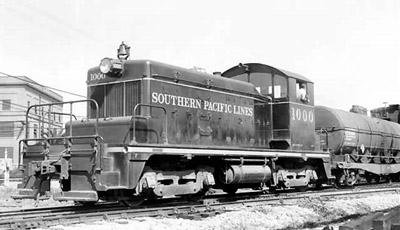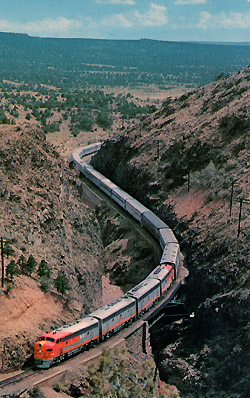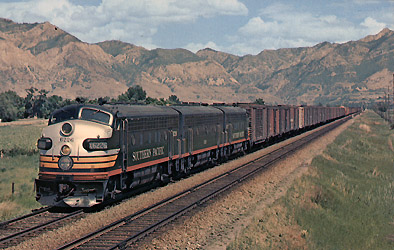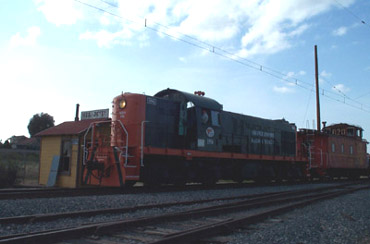Diesel Electric Locomotives add efficiency
 By the middle of the 1930's a new type of locomotive was beginning to appear on American Railways. This new locomotive used a Diesel generator to create electricity which powered axle-mounted electric motors.
By the middle of the 1930's a new type of locomotive was beginning to appear on American Railways. This new locomotive used a Diesel generator to create electricity which powered axle-mounted electric motors.
The original diesel engine was patented by its German inventor, Dr. Rudolph Diesel, in 1892. While the engine proved more energy efficient and consumed less fuel than than a steam engine, it took another 20 years before it was determined how the power produced could be utilized. Various types of transmission were developed, however, the use concept of using the diesel generator for electric motors became the universal method on American railroads.
 First Diesel Electrics Placed is Service
First Diesel Electrics Placed is Service
The first diesel electric locomotive put into service in the United States was a switch engine on the Central Railroad of New Jersey in 1925, built by the American Locomotive Company (ALCO).
The Union Pacific Railroad introduced the Streamliner M-10000, in February 1934, featuring the first internal combustion engine, lightweight streamlined express passenger train in the United States. The M-10000 used a spark-ignition Winton engine running on "petroleum distillate", a fuel similar to kerosene, which produced electricity to power the General Electric traction motors located in the front truck. The car bodies and interior fittings were built by Pullman-Standard. GM artist/engineer Harley Earl helped style the exterior of the M-10000. The train was painted in Armour Yellow with Leaf Brown roof and undersides. The M-10000 was constructed primarily of the lightweight aircraft alloy Duralumin. The new train was exhibited at the 1933-1934 Century of Progress Exposition in Chicago. Subsequent streamliners were diesel powered.
The Chicago, Burlington and Quincy introduced it's new stainless-steel diesel-powered Pioneer Zephyr at the 1933-1934 Century of Progress Exposition. The The Pioneer Zephyr became the first mainline diesel powered passenger train in regular service pulling lightweight, stainless steel, streamlined passenger cars. On May 26, 1934, the reopening day of the Century of Progress Exposition, the sleek, silver Pioneer Zephyr set off on the return from a trip to Denver to run 1,015.4 miles to Chicago in 13 hours, 4 minutes and 58 seconds, an average speed of 76.61 miles per hour, breaking all long distance, nonstop railroad records.
Santa Fe's streamlined Super Chief was the first diesel-powered, all-Pullman sleeping-car train in America, and it eclipsed the Chief as Santa Fe's standard bearer. The extra-fare Super Chief made its maiden run from Dearborn Station in Chicago on May 18, 1937, and covered the 2,225 miles to Los Angeles in just 39 hours and 45 minutes.
Southern Pacific purchased its first seven diesel electric locomotives from EMD, SW-1 switchers in 1939. One of these, SP No. 1006, is preserved at Orange Empire Railway Museum.
 It
wasn't until 1940 that the pioneer freight diesel, model "FT," built by Electro Motive Division of General Motors (EMD) demonstrated that diesels could practically replace steam locomotives in heavy-duty service.
It
wasn't until 1940 that the pioneer freight diesel, model "FT," built by Electro Motive Division of General Motors (EMD) demonstrated that diesels could practically replace steam locomotives in heavy-duty service.
Diesel locomotives slowly replaced steam locomotives as the manufacturing and operational efficiencies made them cheaper to own and operate. While initial costs of diesel engines were high, steam locomotives were custom made for specific railway routes and lines, and as such economies of scale were difficult to achieve. Diesel locomotive parts were more conducive to mass production, making Diesel Locomotives easier to maintain.
Diesel engines didn't require the large amounts of fuel and water that steam locomotives did, and demonstrated better thermal efficiency. Diesel’s theoretical studies demonstrated potential thermal efficiencies for a compression ignition engine of 73% (compared with 6-10% for steam), and his 1897 one-cylinder prototype operated at a remarkable 26% efficiency. By the late 1950's, Diesel locomotives had effectively replaced most steam engines.
The Southern Pacific began using diesel electric locomotives in main line operation in 1947. The last Southern Pacific steam locomotive was retired in 1957.
Diesel Locomotives Preserved at Orange Empire Railway Museum
|
Sharing A Heritage Railroad History Train Technology Railroad Operation Railroad Time Museums & Heritage Railroads Railroads Today

 Orange Empire Railway Museum preserves, exhibits and operates a variety of vintage diesel locomotives, including:
Orange Empire Railway Museum preserves, exhibits and operates a variety of vintage diesel locomotives, including: